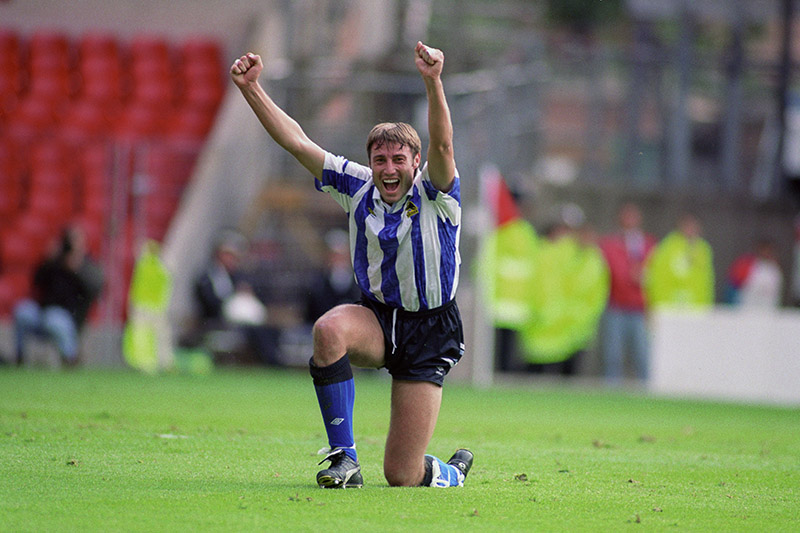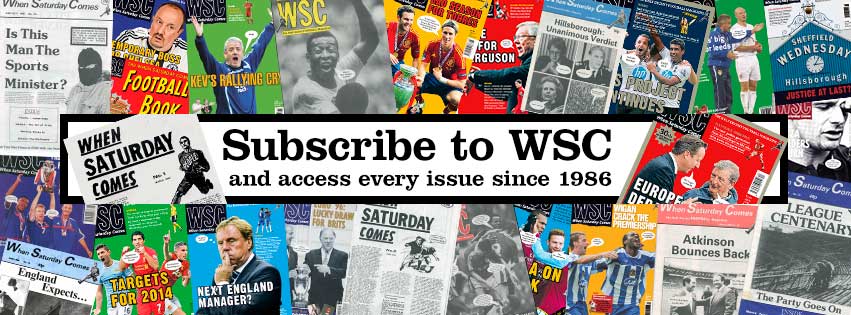
In the early 1990s an unassuming defender was transformed into the hottest forward in England, firing his team to two cup finals before a bittersweet ending
6 July ~ It was one of English football’s unlikeliest purple patches. When Sheffield Wednesday player-manager Trevor Francis converted young centre-back Paul Warhurst into a striker during the second half of the 1992-93 season, his goals propelled the team to two cup finals and earned him a shock England call-up in the process.
Warhurst was an unassuming hero, his achievements delighting fans and neutrals alike. But ultimately, it was a story tinged with disappointment at what might have been.
Aged 21, he was signed by newly promoted Wednesday from Oldham Athletic for the start of the 1991-92 season. Warhurst was soon competing with established duo Nigel Pearson and Peter Shirtliff for a place in the centre of defence. He won Owls fans over in just his second game, calmly bringing the ball out of his own box during a Yorkshire derby away at Leeds, dashing 50 yards up field before setting up striker David Hirst for a fine goal.
Wednesday finished an impressive third that season but shortly into the following campaign star striker Hirst got injured. When Paul Williams was sold and Gordon Watson dropped, Warhurst was picked up front alongside new signing Mark Bright for a league match at Nottingham Forest in September. “When I first mentioned it to him he thought it was a bit of a joke,” said Francis. But Warhurst scored in a 2-1 win.
Next up was a UEFA Cup tie at home to Spora Luxembourg, which Wednesday won 8-1. With Bright ineligible, Warhurst partnered 38-year-old Francis and scored two more goals – though he was dramatically knocked cold by the keeper in the act of heading his second and swallowed his tongue, with only some alert action from the physio saving his life.
Incredibly, despite the scare, Warhurst returned for the second leg and scored again but there his cameo ended, as he struggled on returning to defence and was dropped for a time. Then at the end of January a new injury crisis in attack emerged and again Francis turned to Warhurst.
It was this second spell that stood out. Warhurst became the complete centre-forward. With pace and strength he was a physical problem for defenders. Combined with his two-footed finishing, aerial ability and bravery, he was close to unplayable.
Over a glorious 12-game period Warhurst scored 12 goals and it was his exploits in the cups that caused the biggest stir. In an FA Cup quarter-final under the floodlights at Derby’s Baseball Ground in March he struck twice in a 3-3 draw, then scored the only goal of the replay to send Wednesday to Wembley for an all-Sheffield semi-final against United.
But the greatest away day for Wednesday fans of that generation came in a televised League Cup semi-final first leg at Blackburn a month earlier. After going 1-0 down, Wednesday produced the most magical spell of football imaginable, with four goals in just 16 minutes.
Warhurst gave Colin Hendry a night to forget, tormenting his marker with two brilliant goals; one with his left, the other on his right. A packed Darwen End terrace lapped it up, the cameras catching one fan flinging a set of crutches into the air in celebration at the makeshift striker’s divine intervention.
Throughout this period, the player himself harboured doubts about his abilities as a forward, with the Independent describing him as “The most reluctant striker since Brother Lynk set up his alternative mineworkers union”. That changed when Graham Taylor called him up for England’s World Cup qualifier against Turkey.
It was a bittersweet moment. The man Warhurst credited most with his transformation was Chris Waddle. “He tells me where I should be running and when,” he said at the time. “The service he gives me is marvellous. You’d have to be a fool not to benefit from playing with someone with his experience and ability.” Yet Waddle, to the dismay of Wednesday and England supporters, was consistently ignored by Taylor.
A groin injury kept Warhurst out of the international, but he was back for his club in the FA Cup semi-final win over Sheffield United and the League Cup final defeat against Arsenal, where a partially fit Hirst could only make the bench. Yet when the FA Cup final came around, also against Arsenal, Francis now had problems at the back with Pearson and Shirtliff injured.
It led to a row between Warhurst and his manager, who wanted to play him in defence now Hirst was fit. Warhurst claimed he’d earned a place up front but eventually relented, keeping the No 9 shirt for consolation with Hirst wearing No 5 in attack.
For some fans the episode tainted his previous achievements, while others backed the player. With Warhurst in defence, Wednesday lost to Arsenal after a replay. There would be no tangible reward for a fantastic season that also saw them finish seventh in the league.
Whether or not the row permanently sullied the player’s relationship with Francis is questionable but, after four games of the 1993-94 season, he was sold to Blackburn for £2.7 million. Still just 24, he became the ultimate utility player, shifted between defence, midfield and attack. But his time at Ewood Park was marred by two horrific broken legs, which ruined any hopes of another England call-up. He did at least get a Premier League medal for the part he played in the 1994-95 title win.
Moving on in 1997, Warhurst had spells at Crystal Palace and Bolton, never recapturing his Wednesday form, before dropping into the lower divisions and ending his professional career with Barnet in 2007.
That Cup final selection dispute and career-blighting injuries must leave some regrets. But those who witnessed the events of early 1993, as winter turned to spring, will never forget the time when Paul Warhurst was the hottest property in the land. Johnny Phillips
This article first appeared in WSC 376, June 2018. Subscribers get free access to the complete WSC digital archive – you can find out more here
Photo: PA
